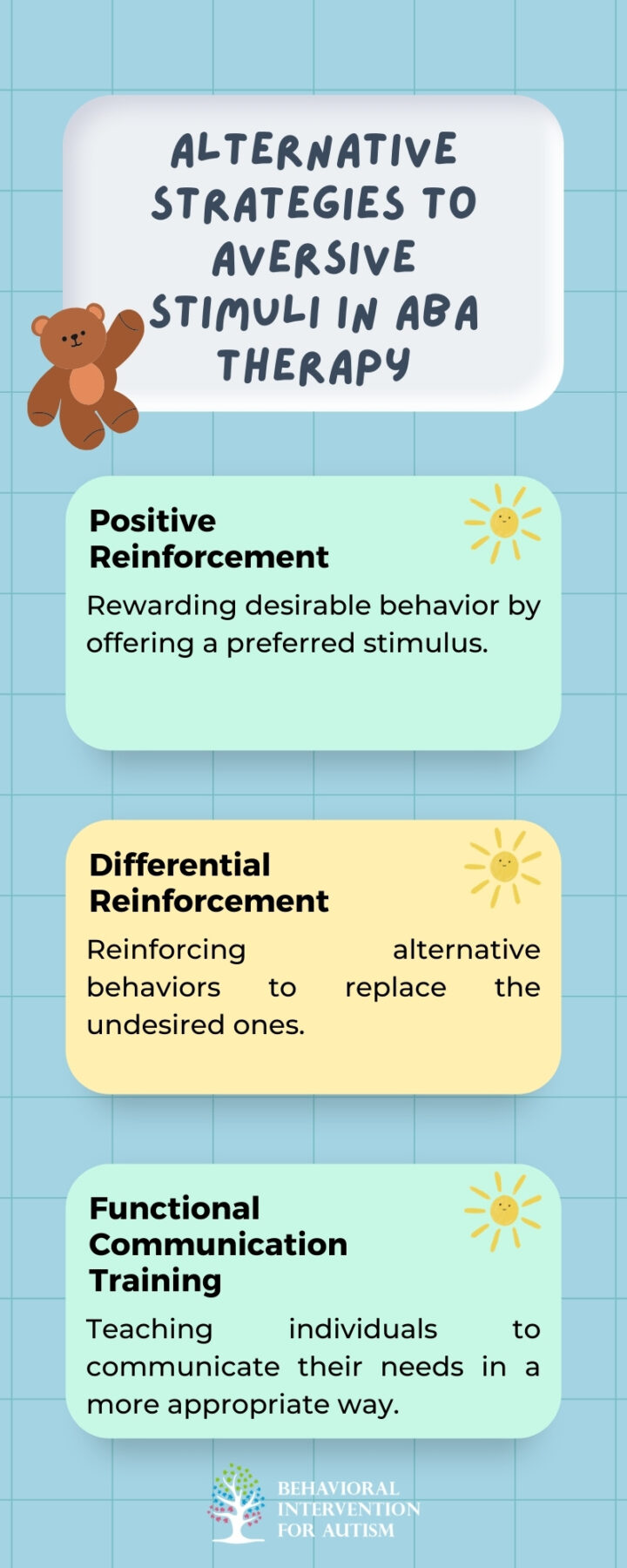
Table of Contents
Aversive stimuli play a crucial role in Applied Behavior Analysis (ABA) therapy, a widely used therapeutic approach for individuals with autism and other behavioral challenges. ABA therapy involves modifying behaviors by reinforcing desirable actions and reducing undesirable ones. Aversive stimuli are typically used to decrease or eliminate undesirable behaviors by introducing negative stimuli to discourage certain actions. This article will explore different examples of aversive stimuli, their role in ABA, and the ethical considerations involved in their use.
What are Aversive Stimuli?
In the context of ABA therapy, aversive stimuli refer to any negative or unpleasant stimulus that, when applied following a behavior, leads to a decrease in that behavior. Aversive stimuli are grounded in principles of operant conditioning, particularly punishment procedures, where an undesired behavior is followed by something that is perceived as uncomfortable or unpleasant to deter the recurrence of the behavior.
These stimuli can be either physical (e.g., an electric shock or a loud noise) or non-physical (e.g., a reprimand or a timeout). Their application aims to suppress specific behaviors by making the experience of engaging in those behaviors less rewarding or reinforcing. However, ethical considerations regarding the use of aversive stimuli have sparked considerable debate within the field of ABA.
6 Examples of Aversive Stimuli in ABA Therapy
In ABA therapy, aversive stimuli are often used to discourage undesirable behaviors by introducing an unpleasant consequence immediately following the action. While these techniques can be effective in modifying behavior, they must be applied carefully and ethically to ensure they promote long-term positive outcomes. Below are some common examples of aversive stimuli used in ABA therapy, each tailored to address specific behaviors and individual needs:
1. Time-Out
Time-out is a common non-physical aversive stimulus used in ABA therapy. It involves removing an individual from a reinforcing environment following a disruptive or undesirable behavior. For example, if a child is engaging in aggressive behavior, a time-out procedure may involve briefly placing the child in a neutral or less stimulating area where they are removed from social or sensory reinforcement.
The intention is to reduce the occurrence of the unwanted behavior by depriving the individual of access to preferred activities or social attention. The aversive effect of time-out comes from the removal of these reinforcing stimuli. It is important for time-out procedures to be applied consistently and appropriately, with the duration of time-out tailored to the individual’s needs.
2. Reprimands
Reprimands, such as verbal warnings or scolding, are another form of aversive stimulus. These are commonly used in ABA to address behaviors that are socially inappropriate or disruptive. A reprimand may involve an adult or therapist saying something like, “That was not acceptable” or “Stop doing that.”
Reprimands are typically brief, clear, and direct. The goal is not to humiliate the individual but to quickly and effectively communicate that the behavior is undesirable. The effectiveness of reprimands as an aversive stimulus largely depends on the individual’s sensitivity to social cues and the severity of the behavior being addressed.
3. Response Cost
Response cost refers to the removal of a reinforcer or privilege following an undesired behavior. For example, if a child loses a token or a privilege (such as playtime) after engaging in problematic behavior, this loss of reinforcement acts as an aversive stimulus.
In response cost procedures, the individual is punished by the withdrawal of something desirable, which increases the likelihood that the undesirable behavior will be reduced or eliminated. This form of aversive stimulus is effective because it directly connects the behavior to a tangible consequence.
4. Overcorrection
Overcorrection is an aversive stimulus that involves requiring an individual to engage in a behavior that exceeds what would be considered appropriate or expected, often in the context of correcting a mistake or inappropriate action. For example, if a child spills something intentionally, overcorrection might require them to clean up the mess, but then they would also need to engage in a more extensive cleaning task, such as scrubbing the floor.
The goal of overcorrection is to discourage undesirable behavior by pairing it with an exaggerated response that makes the individual associate the undesirable behavior with an effortful or unpleasant consequence.
5. Electric Shock
One of the most controversial aversive stimuli used in ABA is the application of electric shock. Electric shock is intended to be a highly aversive stimulus that is used in specific cases to stop dangerous or harmful behaviors, such as self-injurious actions.
This form of punishment is a last resort and is typically used only when other less intrusive interventions have been exhausted. However, its ethical concerns have been significant, and in recent years, there has been a growing movement against the use of electric shock in ABA therapy, particularly due to its potential harm and the negative psychological impact it can have on individuals.
6. Loud Noises or Sounds
Loud noises, such as a sudden, unpleasant sound or a buzz, can also serve as an aversive stimulus. For instance, a therapist might use a buzzer or other unpleasant noise immediately following an undesirable behavior. The loud sound is intended to disrupt the individual’s behavior and encourage them to stop the undesired action.
It is important to note that the use of loud noises must be done with caution, as overly intense or prolonged sounds can be distressing and cause undue anxiety, which can exacerbate behavioral issues.
The Role of Aversive Stimuli in ABA
Aversive stimuli, when applied correctly, can help modify behavior by encouraging individuals to reduce certain undesirable actions. They are used as a part of a broader treatment plan that includes reinforcement strategies to promote positive behavior change. However, their role in ABA is often controversial.
Ethical Considerations in Using Aversive Stimuli
The use of aversive stimuli in ABA therapy has raised ethical concerns. Many professionals advocate for the use of positive reinforcement techniques over punishment-based strategies. The argument is that positive reinforcement, such as rewarding desirable behaviors, is more effective in the long run and less likely to cause harm or distress.
In contrast, aversive stimuli, especially in extreme cases like electric shock, can lead to emotional harm, trauma, and unintended consequences. The potential for these techniques to cause long-term psychological damage has led to calls for more restrictive regulations and ethical guidelines surrounding their use.
The Importance of Consent and Monitoring
In any case where aversive stimuli are used, obtaining informed consent from the individual or their guardians is paramount. This ensures that the individual and their caregivers understand the nature of the intervention and agree to its application. Additionally, regular monitoring is necessary to assess the effectiveness of the intervention and to ensure that no harm is being caused.
Alternative Strategies to Aversive Stimuli in ABA Therapy
While aversive stimuli have their place in some situations, there are many alternative strategies that can be used to address undesirable behaviors without resorting to punishment. These include:

These techniques focus on teaching individuals new, more adaptive behaviors rather than relying on aversive punishment to suppress unwanted ones. They are widely considered to be more humane and effective over the long term.
Aversive stimuli are a complex and controversial aspect of ABA therapy. While they can be effective in certain cases, their use should be carefully considered and applied with caution. Ethical guidelines and professional judgment are essential in determining when, if ever, these stimuli should be used. For most cases, alternative techniques like positive reinforcement offer a more ethical and sustainable approach to behavior modification.
Take Action Now with Behavioral Intervention For Autism
If you’re seeking effective solutions for your child, consider ABA therapy in Florida. At Behavioral Intervention For Autism, we offer personalized support using evidence-based practices to help children thrive. Our expert team is dedicated to delivering high-quality, compassionate care tailored to each child’s unique needs. Whether you’re new to ABA therapy or looking for additional support, we’re here to help. Reach out to us today to learn more about how our services can make a difference in your child’s life. Don’t wait—contact us and start your journey toward progress now!
- 9 Common Obsessions of Children With Autism You Should Know - February 25, 2025
- What is Neurodiversity? A Guide to Embracing Differences - February 25, 2025
- Understanding Hyperfocus in Autism: What It Means and Why It Happens - February 25, 2025


